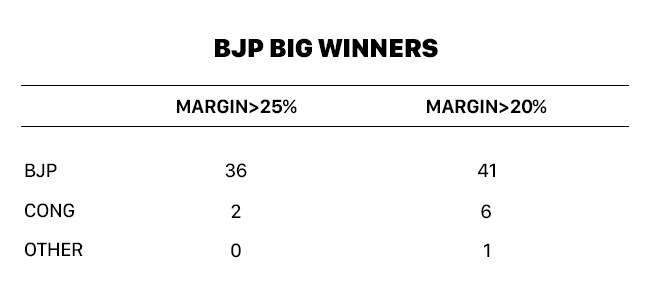Whatever the BJP spin machine may say, falling below 100 seats was an embarrassment they could have done without. And if one looks closely at the numbers, they were only a few 1000s of votes away from losing the election. The number of seats won with less than 1% on either side is such that the election could easily have gone to the Congress - or given the BJP a less humbling majority.
For Rahul Gandhi, the new president of the Congress, victory in Gujarat was a bridge too far. Worse, it was an opportunity lost. For when the campaign began in late October, Gujarat was ripe for the picking and strategic alliances and his own newfound voice should have been enough to carry him over the finish line. And yet, despite Hardik Patel, Jagnish Mevani and Alpesh Thakor, the Congress failed to convert those last dozen seats it needed to come to power. Perhaps it's lack of the ground forces necessary to carry wavering supporters to the polling booth cost them, just as Shah's army of workers made sure that their voters came out.
Data clearly shows that the BJP managed to draw voters even though they lost more than a dozen seats: the BJP actually managed to improve its vote share while dropping seats! And it must be one of the only times in Indian electoral politics that a party getting almost 50% of the vote has actually lost seats.



Compare this with the 14 seats that they lost in rural Gujarat, even though they picked up 2.5% vote share. On the flip side, the inability of the Congress to manage in roads in urban areas must remain a worrying factor. Worry because as India increasingly urbanizes, the Congress has to make itself relevant to towns and their people. One theory is that that the better educated Hindu voter supports the BJP irrespective of its policies because they support Hindutva, while the rural voters are more concerned about their daily lives. Perhaps Rahul Gandhi's temple tours were to reach out to these Hindu votes through "Hindutva Lite". If that is true, it did not work.
Did the Congress alliance with Hardik Patel and Alpesh Thakore, Jignesh Mevani (what the BJP in another communal innuendo called the "HAJ") bear fruit?

Perhaps one of the problems that the Congress faced was that there were enough disenchanted Gujarati voters who did not buy the party as an option. And this may explain the very significant NOTA vote in Gujarat. More than 5 lakh people voted NOTA. That is 1.8% of the voters. And that is a very significant figure because a margin of 1.8% or less determined the fate of 29 seats of which the BJP won 16 and the Congress 13. This is a margin of just 3,000 votes. And at a smaller margin of 2,000 votes, both parties won 9 seats a piece. That's how close this election was.

In north and central Gujarat, the Modi campaign probably did enough to stop the Congress wave from Saurashtra. A look at seats in central Gujarat which voted in two different phases shows a startling difference, even though those in the first phase are a smaller number.
Finally, what does this election mean for the rest of India, and the elections in Karnataka and later in the year for the BJP-held states of Rajasthan, MP, Chhattisgarh and Jharkhand? Firstly, the BJP will not be able to ignore the farmers unrest. So whether it goes for loan waivers or hand outs, expect more for the farmer. Arun Jaitley has already hinted at that yesterday when he promised to boost farm income. Will reforms, like GST, continue or be put on hold? Many reforms don't affect the rural population, ease of business is not something they worry about, so it is unlikely that economic reforms will be affected unless they take away from the rural sector. Will the government be more amenable to listening to others or carry on, on its own merry way? If Modi's speech this evening to BJP supporters is anything to go by, the rhetoric is not going to abate, we are in election mode till 2019, unless it's brought forward to end-2018.
And what about the new Congress? Does Rahul Gandhi have it in him to push himself and his party like he did in Gujarat or was that a flash in the pan? How does he solve the divisions in Rajashtan and MP to have a united party there? All these states should be easier for the Congress with prominent leaders and anti-incumbency; also, in these areas, Modi isn't son of the soil. But Karnataka comes first, and the Congress will need to run a very organized campaign in a state that BJP wants desperately to regain.
(Ishwari Bajpai is Senior Advisor at NDTV.)
Disclaimer: The opinions expressed within this article are the personal opinions of the author. The facts and opinions appearing in the article do not reflect the views of NDTV and NDTV does not assume any responsibility or liability for the same.


